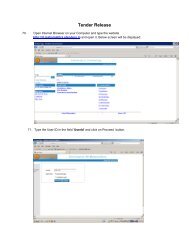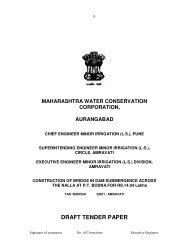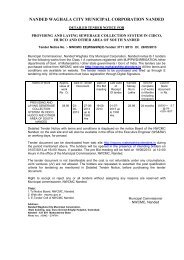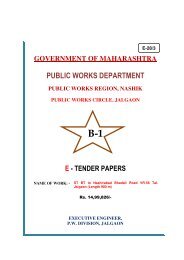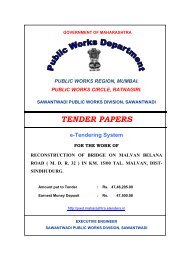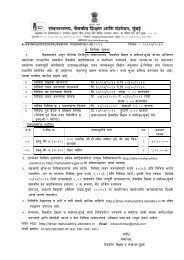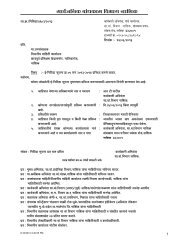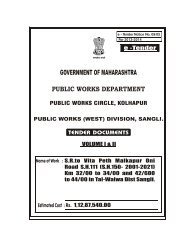B-1 AGREEMENT System Generated e-Tender No ... - e-Tendering
B-1 AGREEMENT System Generated e-Tender No ... - e-Tendering
B-1 AGREEMENT System Generated e-Tender No ... - e-Tendering
Create successful ePaper yourself
Turn your PDF publications into a flip-book with our unique Google optimized e-Paper software.
92 Dy. Executive Engineer<br />
4.2.b) Measurement shall be made using commercially available coating thickness metre which<br />
should be specifically suitable for curved surface.<br />
4.2.c)<br />
The minimum dry film thickness should be ensured atleast on five deformations/ribs over<br />
each one metre length of the coated road.<br />
4.2.d) The thickness of the coating shall also be measured on the straight length of the bar between<br />
the ribs and that also shall not be less than, 125 microns.<br />
4.3 Adhesion of coating.<br />
The adhesion of the coating shall be evaluated by mandrel bent test. The coated rods shall<br />
be bent around a mandrel through 180 as per the test procedure-A given in the Annexure.<br />
When visually examined with unaided eye there shall not be any cracking or disbonding at the<br />
outside radius of the bent bar.<br />
4.4 Relative bond strength in concrete.<br />
The relative bond strength of the coated/uncoated bars shall be evaluated by conducting pull<br />
out test (three cured coated bars and three uncoated bars) as per the procedure given BIS-<br />
2770 Part-1 Methods of testing bonds in Reinforced Concrete Part-1 Pull out Test (1967). The<br />
average bond strength at 0.25 mm slip for coated bar shall not be less than that of the<br />
uncoated bar.<br />
4.5 Resistance to 2v impressed voltage Test.<br />
The resistance of the coating against chloride permeation and the film integrity on the rod<br />
shall be tested by conducting 2v. Impressed voltage test as per the test procedure- B given in<br />
the Annexure. At the end of 1 hour, there shall not be any evolution of hydrogen gas at the<br />
cathode or appearance of corrosion products of iron at the anode.<br />
4.6 The abrasion resistance:<br />
The abrasion resistance of the coating shall be tested by a Taber abraser on coated panels<br />
as per the test procedure- C given in the Annexure. The weight loss shall not exceed 100 mg<br />
/ 1000 cycles.<br />
4.7 Tolerable limit for chloride :<br />
Using anodic polarization technique the tolerable limit for chloride shall be determined as per<br />
the test procedure-D given in the Annexure. For cement polymer rod it shall not be less than<br />
10,000 PPM.<br />
4.8 Chemical Resistance of the coating :<br />
The chemical resistance of the coated bar shall be evaluated as per the test procedure-E by<br />
partially keeping the coated rods immersed in the following four environments for 45 days.<br />
a. 3M NaOH b. 3M CaCl2 c. Saturated CA (OH) 2 d. Distilled water.<br />
At the end of the test period, when visually examined there shall not be any blistering,<br />
softening or peeling on the coated rods.<br />
4.9 Impact Resistance of the coating:<br />
The resistance of the coated rebar to mechanical damage be assessed by standard falling<br />
weight test as per the test procedure-F with an impact force of 9 N-m . <strong>No</strong> shattering, cracking<br />
or bond-loss of the coating shall be observed except at the impact area.<br />
5. ACCEPTANCE/INSPECTION<br />
5.1 The coated rods that do not meet the requirements of the above specification shall be<br />
rejected.<br />
5.2 The manufacturer of the coated rebar, shall submit a certificate from an appropriate testing<br />
agency that the coated rebars meet the requirements of the specification.<br />
Signature of Contractor <strong>No</strong>. Of Corrections Executive Engineer



